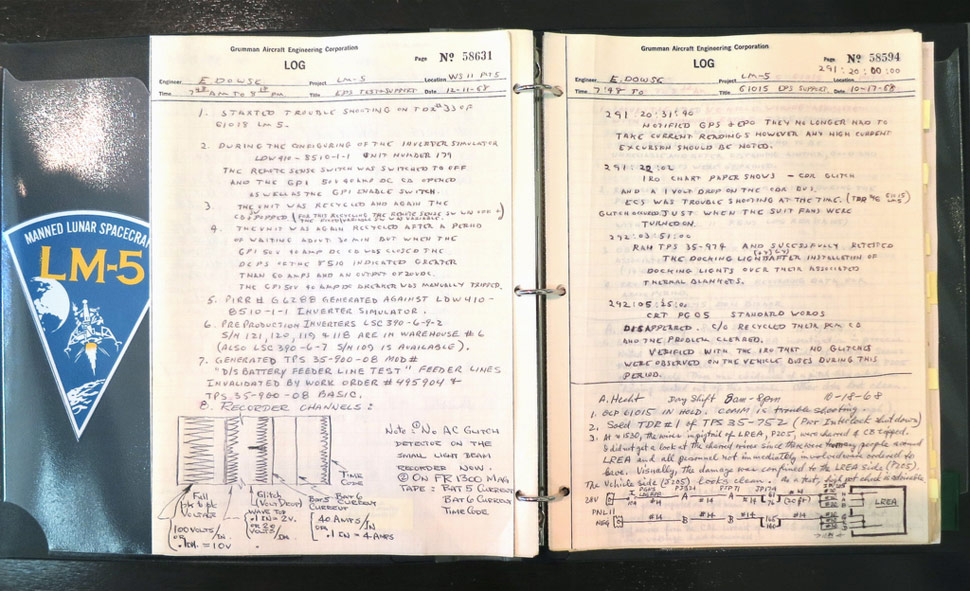How the Eagle Landed: Grumman Construction Log, and a message to space (Apollo 11)

On the anniversary of Apollo 11, Steve Jurvetson posted an amazing, never-before-seen series of space artifacts. He writes:
On July 20, 1969, Eagle landed on the moon. These are the handwritten notes from the Grumman engineers as they pushed to complete Lunar Module LM-5 in 1968. On the last page, they learn than this particular Lunar Module would be the one to bring the first humans to the moon.Here's the Flickr page, with lots more details, and lots more links.
The Grumman Engineering Log served not only as an engineering notebook but also as an intercom between the day and night shift – separate teams that needed to push the ball forward from where the other left off. So we are offered a rare peek into the concerns, uncertainties and conversations that might have otherwise been quietly undocumented.
This log has informed the writing of Pellegrino’s book Chariots for Apollo, but only a few scholars have had access to these pages to date. Heritage reported that this original document is the only one in existence, with no copy on file anywhere. So I thought it would be good to make a color scan of the entire book, and make it available to all. So, here is the PDF file (8MB).
My hope is that we can collectively decode some of its mysteries, or better yet, find some of the engineers to see if it jogs their memories. There is a list of all of the engineers on p.2. We only have first initial and last names. So any insights to the full names or their whereabouts would be appreciated.
I am also hoping that space historians who come across interesting passages can share what they know in the comments below (with reference to date or page number). Are any of the part numbers significant, especially those swapped between the Apollo 9,11,12 and 13 Lunar Modules? I will also add a glossary of acronyms below as we decode them. Also, if anyone can OCR the hybrid handwriting, please do. Our attempts with free OCR tools have failed so far.
 At left, Steve with a prototype build of the first flagpole assembly on the moon.
At left, Steve with a prototype build of the first flagpole assembly on the moon. "I brought it to Buzz Aldrin, and his eyes went wide," he says. "But from what I learned, there probably is no Apollo 11 flag on the moon today."
How exciting. Happy space-a-versary, everyone!
And here's another amazing artifact photographed by Steve, below: a silicon disc, FROM PLANET EARTH.
On the Flickr page for this photo, Steve writes:
On this day in 1969, Apollo 11 took flight to the moon. In the days that preceded the launch, the U.S. scrambled to pull together the messages from Earth that would be left behind on the moon. This is the Apollo Goodwill Disc, and it was engineered to last long after the U.S. flag was destroyed."
This silicon disc contains etched letters (scanned and reduced 200x) from the leaders of the world’s nations. This is one of the discs produced by Sprague and retained by a Sprague manager; a second resides in the Smithsonian, and a third rests on the Moon's Sea of Tranquility, deposited there by Buzz Aldrin.
(Does anyone know if other builds remain intact? A Sprague press release says that of the handful of discs made, one was given to President Nixon and one to President Johnson).
It is a tricky subject matter for photography. I wanted to capture the angle-dependendent iridescence of the semiconductor thin films. The overhead light source reflects off the leather seat cushion, revealing the shift from green to purple that occurs at oblique angles.
This comes from the early days of the semiconductor industry, when Apollo consumed 50% of global production, and wafers were just 2” wide (the ultimate disc was cropped around the 1.5” metallized ring and placed in a aluminum case).


No comments:
Post a Comment